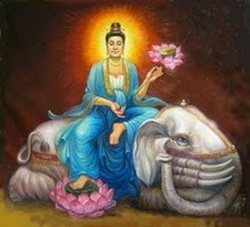Difference between revisions of "Brahmacarya"
(Created page with "thumb|250px| Brahmacharya (/ˌbrɑːməˈtʃɑrjə/; {{Wiki|Devanagari}}: ब्रह्मचर्य behavior that leads to {{Wiki|Brahman}...") |
|||
| (2 intermediate revisions by the same user not shown) | |||
| Line 1: | Line 1: | ||
[[File:Puxianpusa.jpg|thumb|250px|]] | [[File:Puxianpusa.jpg|thumb|250px|]] | ||
| − | [[Brahmacharya]] (/ˌbrɑːməˈtʃɑrjə/; {{Wiki|Devanagari}}: [[ब्रह्मचर्य]] behavior that leads to {{Wiki|Brahman}}) is one of the four stages of life in an age-based social system as laid out in the Manu Smrti and later Classical {{Wiki|Sanskrit}} texts in {{Wiki|Hinduism}}. It refers to an educational period of 14–20 years which starts before the age of puberty. During this time the traditional {{Wiki|vedic}} sciences are studied, along with the religious texts contained within the {{Wiki|Vedas}} and {{Wiki|Upanishads}}. This stage of life was characterized by the practice of strict celibacy. | + | [[Brahmacharya]] (/ˌbrɑːməˈtʃɑrjə/; {{Wiki|Devanagari}}: [[ब्रह्मचर्य]] {{Wiki|behavior}} that leads to {{Wiki|Brahman}}) is one of the four stages of [[life]] in an age-based {{Wiki|social}} system as laid out in the [[Manu Smrti]] and later Classical {{Wiki|Sanskrit}} texts in {{Wiki|Hinduism}}. It refers to an educational period of 14–20 years which starts before the age of puberty. During this [[time]] the [[traditional]] {{Wiki|vedic}} {{Wiki|sciences}} are studied, along with the [[religious]] texts contained within the {{Wiki|Vedas}} and {{Wiki|Upanishads}}. This stage of [[life]] was characterized by the practice of strict {{Wiki|celibacy}}. Lit., [[Brahma]] or [[purified life]], usually connoting the practice of [[celibacy]]. |
| − | Among the {{Wiki|Hindu}} monastic as well as sramanic traditions, [[Brahmacharya]] is the term used for the practice of self-imposed {{Wiki|celibacy}} that is generally considered an essential prerequisite for spiritual practice. These characteristics correspond to Western notions of the religious life as practiced in monastic settings. | + | Among the {{Wiki|Hindu}} [[monastic]] as well as [[sramanic]] [[traditions]], [[Brahmacharya]] is the term used for the practice of self-imposed {{Wiki|celibacy}} that is generally considered an [[essential]] prerequisite for [[spiritual]] practice. These {{Wiki|characteristics}} correspond to {{Wiki|Western}} notions of the [[religious]] [[life]] as practiced in [[monastic]] settings. |
{{W}} | {{W}} | ||
{{SanskritTerminology}} | {{SanskritTerminology}} | ||
Latest revision as of 18:31, 21 March 2014
Brahmacharya (/ˌbrɑːməˈtʃɑrjə/; Devanagari: ब्रह्मचर्य behavior that leads to Brahman) is one of the four stages of life in an age-based social system as laid out in the Manu Smrti and later Classical Sanskrit texts in Hinduism. It refers to an educational period of 14–20 years which starts before the age of puberty. During this time the traditional vedic sciences are studied, along with the religious texts contained within the Vedas and Upanishads. This stage of life was characterized by the practice of strict celibacy. Lit., Brahma or purified life, usually connoting the practice of celibacy.
Among the Hindu monastic as well as sramanic traditions, Brahmacharya is the term used for the practice of self-imposed celibacy that is generally considered an essential prerequisite for spiritual practice. These characteristics correspond to Western notions of the religious life as practiced in monastic settings.
